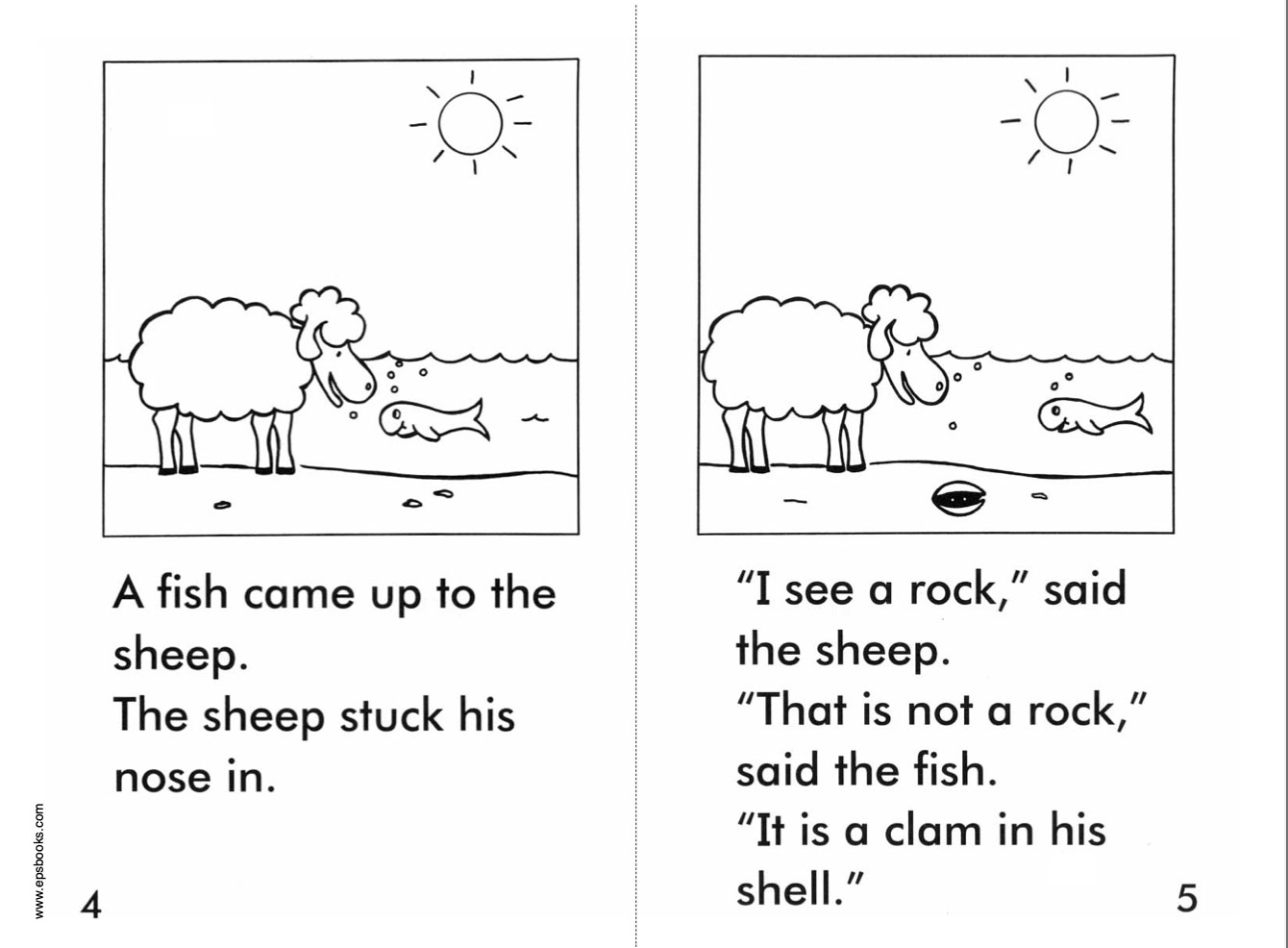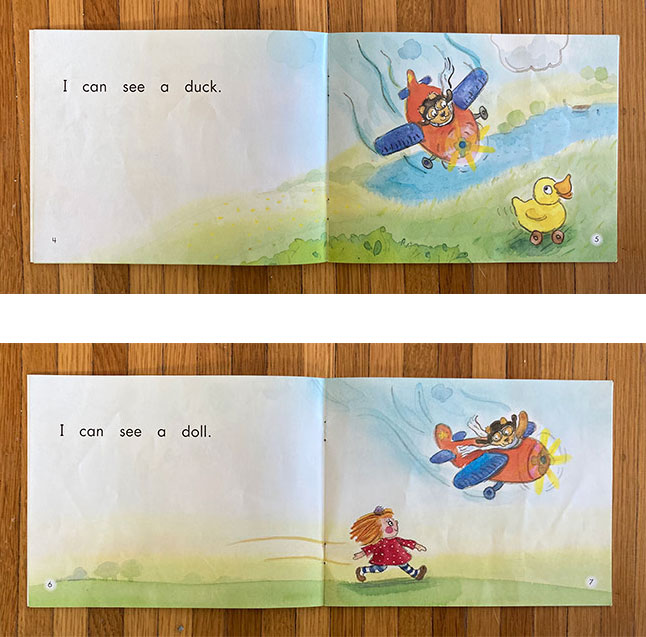Books for practicing letter-sound relationships
Decodable books allow students to practice and apply the letter-sound relationships they are learning. To be considered a decodable book, at least 64% or more of the words can be identified using phonics elements.
Although controversy exists over how much time should be spent using decodable texts, most educators agree that there is a window when using these texts helps children practice, apply, and master decoding skills.

Most of the words in a decodable text use regular phonics element and can be sounded out.
What is a decodable book?
Decodable texts allow students to practice the letter-sound relationships they are learning in phonics. They can be in the form of books, short texts, or even words, phrases, or sentences for practice. To be considered “decodable”, a text must contain at least 64% or more words with regular phonetic features. Students must use what they know about the sound-letter relationships to figure out unknown words.
With so much variation among publishers, is one kind of decodable text better than another? Not really. In an Education Week interview, Dr. Elfrieda Hiebert explained what to look for when choosing decodable texts (see: ‘Decodable’ Books: Boring, Useful, or Both? ):
- Does the text contain highly consistent patterns?
- Are the phonics features repeated many times throughout the text? Students benefit from multiple exposures and practice when learning to read the words.
- Does the text make sense and build a reader’s knowledge? Since they rely on specific phonetic patterns in words, many decodable texts fall short in this category.
Patterned/predictable texts
Decodable texts are often compared to patterned/predictable texts. Sometimes these texts are labeled as leveled texts. Leveled text is any text that has been assigned a difficulty level based on text elements, such as number and length of words, illustrations, font style and size, etc. Patterned/predictable text is one type of a leveled text, but decodable books can also be assigned a difficulty level, too.
Pattern/predictable texts repeat consistent words, phrases and sentences or rhyme and rely on natural language patterns to make the words easier to read and remember. Students don’t have to rely solely on matching sounds and letters to read these books. Because patterned books use a variety of words that are not easily decoded, they don’t provide novice readers with sufficient decoding practice and may lead to a habit of guessing unknown words.

A steady diet of pattern/predictable books does not promote the use of effective word reading strategies.
When should you use decodable text?
When students first learn how to read, they benefit from decodable texts that allow them to apply what they learned in phonics in a connected text. Books where most of the words require you to use letter-sound knowledge will encourage the reader to rely on and use their letter-sound knowledge instead of using less reliable supports for reading words, such as context clues or looking at the pictures.
Decodable texts give novice readers a chance to practice matching up letter-sound relationships and builds a habit of analyzing the letters and sounds to read unfamiliar words.
Most teachers use decodable texts during and after teaching a phonics lesson. By carefully choosing texts that align with taught sounds and patterns, students can immediately put what they learn during phonics to use in print.
How long should students work with decodable text?
Decodable texts are an essential part of practice for early readers, says Dr. Louisa Moats, author of the LETRS professional development for teachers. But students shouldn’t use them for too long. She discusses the importance of reinforcing sound-letter correspondences with decodables and how to know when it’s time to move on. (From our sister site, Reading Universe )
What does the research say?
Although some schools have advised teachers to use only decodable text with primary grade students, the existing research does not support that practice.
Very few empirical studies have looked at manipulating the type of text. Five studies have examined decodable text and its influence on reading with contrasting outcomes (Compton, Appleton, Hosp, 2004; Jenkins et al., 2004; Juel & Roper/Schneider, 1985; Mesmer, 2001a; 2005; Vadasy, Sanders, & Peyton, 2005).
In a famous study, Juel and Roper-Schneider (1985) concluded that the type of text used during the first part of the first grade year contributed to the use of a letter/sound strategy. Decodable text facilitated the transfer of letter/sound knowledge through the end of the first grade and did so even more than phonics instruction.
Mesmer et al (2010) compared reading decodable vs. leveled text across the year with 74 first graders. The students read the different types of texts twice in fall and twice in the winter/spring. The authors examined whether reading the different text type influenced children’s reading accuracy and automaticity. Although leveled and decodable texts had similar outcomes for reading accuracy, the first graders who read leveled texts were more automatic than the students who only read decodable texts. Their reading rate may have been enhanced by the highly repetitive, “predictable” books with high numbers of repeated high frequency words. The authors suggested that decodable texts may not necessarily lead to automaticity, but they do foster the use of specific word reading strategies.
Jenkins et al. (2004) conducted an experiment investigating the role of text decodability in a one-on-one supplemental tutoring program with struggling first grade readers and found that direct instruction in phonics trumped the type of text used. In other words, there was no advantage for students who read leveled text plus phonics instruction vs. students who read decodable text plus phonics instruction. Students who read leveled and decodable texts made gains, but it was the phonics instruction received around the texts that made the difference.
So, what’s the take away here? There is a short window when beginning readers will benefit from decodable texts to learn how to identify words (Mesmer, 2010). As soon as children can read words accurately and smoothly, teachers can move beyond using decodable books.
Even within this window, exposing students to a diverse range of texts will expose them to a wider variety of words and irregular words. If you’re going to select texts for your beginning readers, be aware of the small but important advantages that decodable texts offer learning to decode accurately and practice applying word reading strategies.
How to use decodable text
Jenkins, Vadasy, Peyton, and Sanders (2003) provide suggestions for teachers to choose and use decodable books:
- Inspect the phonic elements featured in the desired text.
- Compare the featured elements in the chosen text with the phonics knowledge of your students.
- Choose books containing letter-sound patterns that students have mastered for independent reading.
- For teacher-directed reading instruction, choose books whose phonic elements align with what students are learning.
- Before reading, note any irregular words and be prepared to support students if they cannot figure these words out on their own.
Previewing decodable texts will be sparse compared to a leveled book. You may point out a specific phonics element or model what to do for reading unknown words. Since most words in a decodable book can be sounded out, you don’t want to remove the decoding challenge of the text.
During and after the reading, teachers should highlight a few words and discuss the word identification strategies students used. Although some decodable texts may lack a classic story structure or natural language, you can still discuss a few questions related to the meaning of the text. Just keep in mind that your primary focus for reading this type of text is to focus on word recognition.
You can use decodable books to help children understand that all letters matter in words and to provide repeated exposures to learn letter-sound relationships to mastery. Remember, it’s your skillful use of instruction before, during and after the reading that makes using decodable books an effective choice for beginning readers.
Finding decodable texts
Free decodable texts aligned with phonics skills
Use this scope and sequence to match a decodable text with the spelling pattern you’re teaching: Free Decodable Texts for Each Phonics Skill . (From our sister project, Reading Universe)
Decodables from publishers
This list of links, compiled by The Reading League, includes decodable text sources for students in grades K-2, 3-8, teens, and all ages. Decodable Text Sources ›
More resources on decodable text
Curriculum and Instruction
What Are Decodable Books and Why Are They Important?
Right to Read
The Drudgery (and Beauty) of Decodable Texts
Classroom Strategies
Matching Books to Phonics Features
Shanahan on Literacy
Should We Teach with Decodable Text?
Shanahan on Literacy





